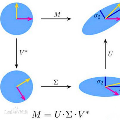We present a data-driven approach to mathematically model physical systems whose governing partial differential equations are unknown, by learning their associated Green's function. The subject systems are observed by collecting input-output pairs of system responses under excitations drawn from a Gaussian process. Two methods are proposed to learn the Green's function. In the first method, we use the proper orthogonal decomposition (POD) modes of the system as a surrogate for the eigenvectors of the Green's function, and subsequently fit the eigenvalues, using data. In the second, we employ a generalization of the randomized singular value decomposition (SVD) to operators, in order to construct a low-rank approximation to the Green's function. Then, we propose a manifold interpolation scheme, for use in an offline-online setting, where offline excitation-response data, taken at specific model parameter instances, are compressed into empirical eigenmodes. These eigenmodes are subsequently used within a manifold interpolation scheme, to uncover other suitable eigenmodes at unseen model parameters. The approximation and interpolation numerical techniques are demonstrated on several examples in one and two dimensions.
翻译:在数学模型物理系统中,我们通过学习与Green相关的功能,对指导部分差异方程式的不为人知的物理系统进行了数据驱动的数学模型处理。通过从高斯进程提取的引力,通过收集输入-输出对系统响应,对主题系统进行观察。提出了两种方法来学习Green的功能。在第一个方法中,我们使用系统的正正正正正正正正正正正方形分解(POD)模式,作为绿色功能的二次元体的代金,并随后使用数据来适应二次元值。在第二个方法中,我们使用随机特异值解构(SVD)对操作者进行一般化,以构建绿色功能的低端近似值。然后,我们提出一个多重的内向机制,用于离线设置,在特定的模型参数下,离线解析解析数据被压缩为经验性电子元模型。这些电子元模型随后在一个多维的内被使用,用来在多个不同的内位图中发现其他适当的数字模型和数字参数。




